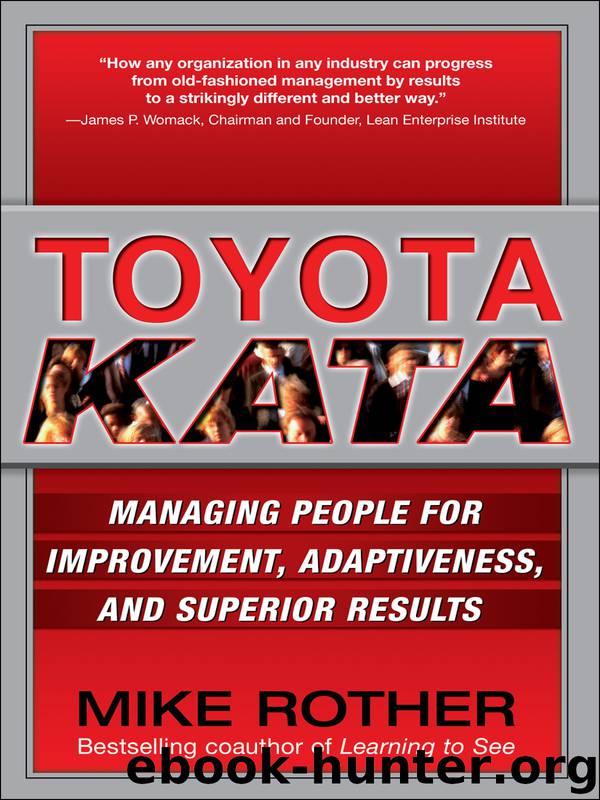Toyota Kata by Mike Rother

Author:Mike Rother
Language: eng
Format: epub
Publisher: McGraw-Hill Education
Published: 2010-11-19T05:00:00+00:00
Toyota Is More Interested in What Does Not Go as Planned
The thinking reflected in Figure 6-8 is fundamental in Toyota’s improvement kata.
“NO PROBLEM” = A PROBLEM
Figure 6-8. A different way of thinking
Interpretation: if there is no problem, or it is made to seem that way, then our company would, in a sense, be standing still. Toyota’s management wants the organization to see and utilize small problems in order to exploit the potential they reveal, and before they affect the external customer. If people are threatened by problems, then they will either hide them or conduct poor problem solving by quickly jumping to countermeasures without sufficiently analyzing and understanding the situation. The idea is to not stigmatize failures, but to learn from them.
To function in this way, the improvement kata should be depersonalized and have a positive, challenging, no-blame feeling. Toward that end, at Toyota an abnormality or problem is generally not thought of or judged good or bad, but as an occurrence that may teach us something about our work system. This can be somewhat difficult for westerners to understand: something can be a problem—a situation that we do not want—without it necessarily being considered good or bad. This is akin to the difference between “understanding” and “accepting.” Trying to understand a situation and why it happens does not mean you have to accept it. Making this distinction will make you a better problem solver. Interestingly, if you look up problem in the dictionary, you won’t find the negative connotation that we often assign to this word.
For example, at a Toyota assembly plant, I once was told that the normal number of andon pulls is typically around 1,000 per shift. Each pull is an operator calling for assistance from their team leader because the operator is experiencing a problem; a cross-threaded bolt here, a task that took a little too long there. Naturally, the number of andon pulls per shift varies, and I once heard of it dropping to only 700 pulls/shift. When I ask non-Toyota managers what they would do in this situation, I often get the answer, “We would celebrate the improvement.”
According to my source, what actually happened when the number of andon pulls dropped from 1,000 to 700 per shift is that the Toyota plant’s president called an all-employee meeting and said, “The drop in andon pulls can only mean two things. One is that we are having problems but you are not calling for help. I want to remind you of your responsibility to pull the andon cord for every problem. The other possibility is that we are actually experiencing fewer problems. But there is still waste in our system and we are staffed to handle 1,000 pulls per shift. So I am asking group leaders to monitor the situation and reduce inventory buffers where necessary so we can get back to 1,000 andon pulls per shift.” This is quite a contrast to our current thinking.
Another example came while touring a U.S. vehicle assembly plant in Detroit with a group that included a former Toyota executive.
Download
This site does not store any files on its server. We only index and link to content provided by other sites. Please contact the content providers to delete copyright contents if any and email us, we'll remove relevant links or contents immediately.
Hit Refresh by Satya Nadella(8854)
The Compound Effect by Darren Hardy(8512)
Change Your Questions, Change Your Life by Marilee Adams(7374)
Nudge - Improving Decisions about Health, Wealth, and Happiness by Thaler Sunstein(7242)
The Black Swan by Nassim Nicholas Taleb(6767)
Deep Work by Cal Newport(6563)
Daring Greatly by Brene Brown(6225)
Rich Dad Poor Dad by Robert T. Kiyosaki(6176)
Principles: Life and Work by Ray Dalio(5961)
Man-made Catastrophes and Risk Information Concealment by Dmitry Chernov & Didier Sornette(5649)
Playing to Win_ How Strategy Really Works by A.G. Lafley & Roger L. Martin(5503)
Digital Minimalism by Cal Newport;(5389)
Big Magic: Creative Living Beyond Fear by Elizabeth Gilbert(5352)
The Myth of the Strong Leader by Archie Brown(5238)
The Slight Edge by Jeff Olson(5200)
Discipline Equals Freedom by Jocko Willink(5157)
The Motivation Myth by Jeff Haden(5004)
Stone's Rules by Roger Stone(4857)
The Laws of Human Nature by Robert Greene(4773)
